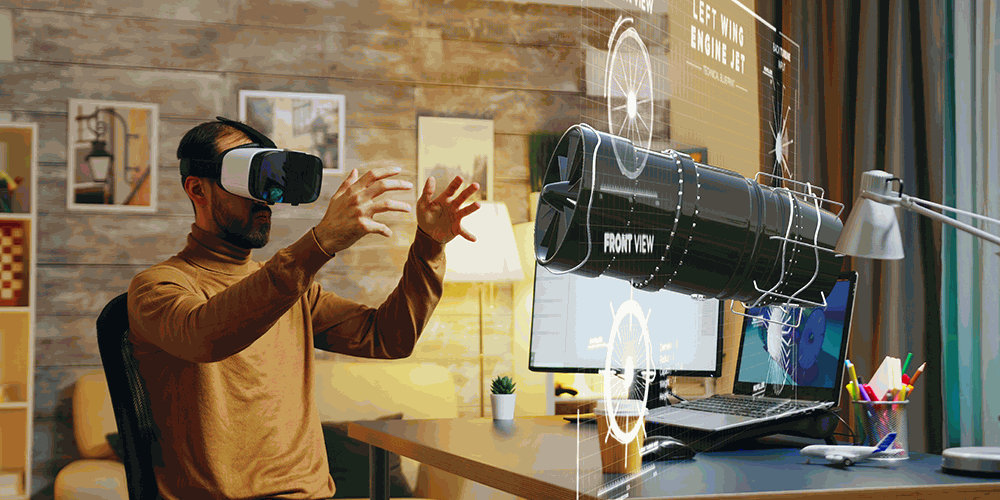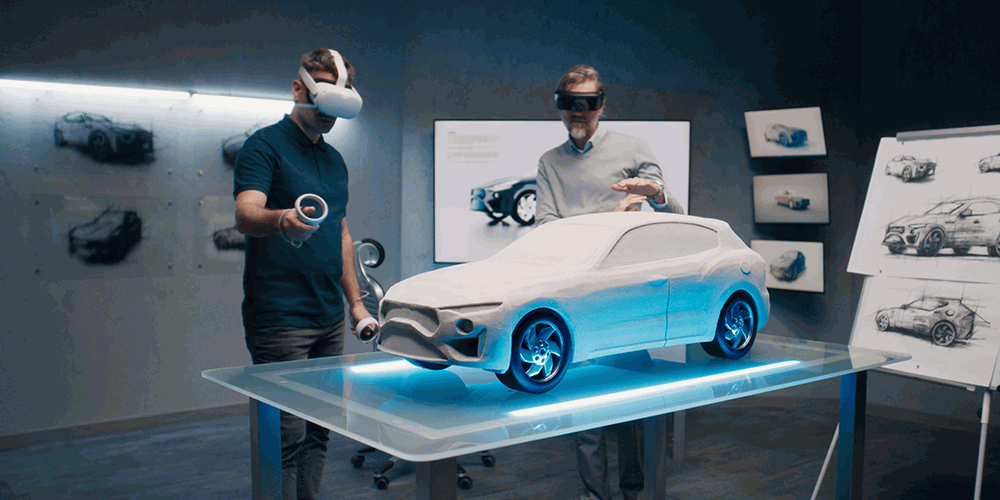VR for Product Prototyping and Design: How Mechanical Engineering Can Use It

In a world where industries are advancing faster than ever, keeping up with technology is no longer optional, it has become a must for success. Mechanical engineering, the field of designing machines and systems, is changing too.
But the old methods we used to rely on aren't enough for today's industries. That's where virtual reality (VR) comes in. It's not just another fancy tool.
It's like a magical bridge that turns ideas into real things helping engineers take their thoughts and turn them into actual, working products.
In this blog, we'll explore how VR for product prototyping and design is changing the way engineers think about, create, and improve mechanical systems.
It's a journey into a world where imagination becomes reality, and where engineers can make things in ways they never could before.
VR in Mechanical Engineering Education
Mechanical engineering colleges are increasingly recognizing the profound impact that Virtual Reality (VR) can have on their curricula.
But why is VR gaining such prominence in engineering education?
The answer lies in the transformative benefits it offers to students, fundamentally enhancing their learning experiences.
Traditionally, engineering students have grappled with static diagrams and two-dimensional representations of complex machinery.
While these conventional teaching methods undoubtedly have their place, they often fall short in conveying the intricate details and dynamics of real-world engineering systems.
Virtual reality for mechanical engineering allows students to engage with intricate engineering concepts in an immersive and hands-on manner.
Instead of peering at lifeless diagrams, they can step into a virtual world where 3D models come to life.
This dynamic approach to learning empowers students to gain a deeper understanding of the inner workings of machines and mechanisms.
It's as if they have access to a virtual engineering laboratory, where they can disassemble, reassemble, and interact with components, learning through exploration and experimentation.
But VR engineering doesn't stop at merely enhancing theoretical knowledge.
It has a unique ability to prepare engineering students for the real challenges they'll encounter in their careers.
By simulating real-world scenarios and environments, VR equips students with practical skills that go beyond theory.
It fosters problem-solving abilities, critical thinking, and adaptability, all of which are indispensable in the engineering industry.
One of the most exciting and innovative applications of VR in engineering education is the concept of virtual industrial visits.
These virtual tours transcend the boundaries of physical classrooms, enabling students to venture into the heart of manufacturing plants, laboratories, and industrial facilities without ever leaving their seats.
Imagine students donning VR headsets to explore the intricacies of the production process of the Turbofan Jet Engine.
They can witness the assembly of components, observe quality control procedures, and even experience the sounds and vibrations of a real manufacturing environment.
Virtual industrial visits offer students a firsthand look at the challenges and complexities of real-world engineering.
Whether it's understanding the precision required in aerospace manufacturing or witnessing the intricacies of quality assurance in a production line, VR empowers students to comprehend the nuances of their future professions.
It's a transformative tool that makes engineering education more engaging, relevant, and aligned with the demands of modern industry.
Advantages of VR for Product Design

Why should institutions use VR to train engineering students?
To answer this, let's delve into the advantages of VR in product design, highlighting its transformative impact on 3D modeling, Virtual Reality Aided Design (VRAD), and hands-on training.
✔️ Enhanced 3D Modeling in Mechanical Engineering
One of the core aspects of product design in mechanical engineering is 3D modelling.
Let's delve into the advantages of VR in product design, highlighting its transformative impact on 3D modeling, Virtual Reality Aided Design (VRAD), and hands-on training.
But, VR takes 3D modelling to the next level.
With VR, engineers can immerse themselves in a 3D environment, which facilitates better understanding and decision-making.
Imagine being able to walk around and interact with your 3D models as if they were real physical objects.
This immersive experience offers engineers a unique advantage. They can spot design flaws, assess proportions, and optimize products for both performance and user experience with remarkable precision.
VR empowers engineers to address potential issues before they manifest in the physical world, saving valuable time and resources in the product development process.
✔️ Immersive Experience of Virtual Reality Aided Design
Virtual Reality Aided Design (VRAD) is an emerging field that combines the precision of CAD (Computer-Aided Design) with the immersive capabilities of VR.
It enables engineers to design and manipulate 3D objects in a virtual environment.
VRAD provides engineers with a groundbreaking platform to design and manipulate 3D objects within a virtual environment.
This means you can create, modify, and analyze product prototypes in VR, as though they were tangible objects right before your eyes.
This revolutionary approach to design offers an intuitive and dynamic process that accelerates product development.
VRAD reduces the gap between the digital and physical worlds, resulting in faster, more accurate product development.
VRAD empowers engineers to collaborate seamlessly, regardless of geographical distances. It fosters real-time collaboration, allowing multiple experts to work on a project simultaneously within the same virtual space.
This results in more efficient teamwork, accelerated innovation, and ultimately, superior products.
✔️ Hands-On Training with VR
The advantages of VR extend beyond design into education and training
VR offers an unparalleled advantage. In particular, VR revolutionizes the way engineering students prepare for their future careers.
VR-based hands-on training provides students with unparalleled advantages.
Students can practice assembling and disassembling complex machinery, troubleshooting problems, and simulating real-world scenarios, all in a safe and virtual environment.
This hands-on training prepares them for the challenges of the industry, ensuring they are job-ready upon graduation.
They graduate job-ready, possessing a level of familiarity with real-world challenges that is difficult to attain through traditional education methods.
Furthermore, VR simulations for product prototyping allow students to refine their design skills and innovate in ways that traditional methods cannot match.
They can experiment, iterate, and innovate in ways that were previously constrained by physical limitations.
This fosters a culture of creativity and continuous improvement, which is crucial for the ever-evolving field of mechanical engineering.
Challenges and Considerations
Though Virtual Reality (VR) promises a revolutionary approach to mechanical engineering education and product design, it does come with its share of challenges and considerations.
Two major aspects to keep in mind are the technical challenges associated with implementation and the need for effective training and adoption strategies. These are explained below-
✔️ Technical Challenges
Implementing VR in mechanical engineering colleges requires significant hardware and software investments. This financial commitment includes considerations such as:
VR Headsets
Acquiring high-quality VR headsets that offer immersive experiences can be expensive. These headsets need to be robust enough to handle the demands of engineering applications.
Powerful Computers
VR applications often require powerful computers with advanced graphics processing units (GPUs) and ample memory. Upgrading or purchasing new computers to meet these requirements can strain institutional budgets.
VR Software Licenses
The acquisition of VR software licenses can add to the overall cost. These licenses ensure access to the latest VR applications and tools necessary for effective learning and design.
However, as technology advances and becomes more accessible, these challenges are becoming easier to overcome.
The market is witnessing a broader range of VR hardware options, including more affordable headsets with impressive capabilities.
Additionally, the growing demand for VR technology in various industries is driving competition and innovation, potentially lowering costs over time.
As colleges and institutions explore partnerships and funding opportunities, the financial barriers to VR adoption are likely to decrease.
✔️ Training and Adoption
Another challenge is ensuring that faculty and students are proficient in using VR tools effectively.
Resistance to change can be a significant hurdle when introducing new technology into educational settings. To address this, institutions should prioritize the following:
Faculty Training
Equipping instructors with the necessary skills to incorporate VR into their teaching methods is crucial.
Professional development programs and workshops can help educators become proficient in using VR as a teaching tool.
Student Training
Students must receive proper training in using VR for both educational and design purposes.
This training should not only cover the technical aspects but also emphasize the value and real-world applications of VR in mechanical engineering.
Technical Support
Establishing a reliable support system is essential to address technical issues promptly.
This ensures that both faculty and students can access technical assistance when needed, reducing frustration and enhancing the overall experience.
Promoting Awareness
Communicating the benefits of VR and its role in improving learning and design processes is crucial.
Raising awareness about the advantages of VR can mitigate resistance and increase enthusiasm for its adoption.
Future Prospects of VR in Mechanical Engineering
As VR technology continues to evolve, we can expect exciting developments in the field of mechanical engineering.
Emerging trends such as haptic feedback devices, augmented reality overlays, and AI-driven simulations promise to further enhance the design and prototyping process. VR is not just a tool; it's a gateway to innovation and creativity in engineering.
Conclusion
In conclusion, Virtual Reality for product prototyping and design is more than a trend. This is a transformative force in the world of mechanical engineering.
Mechanical engineering colleges have a unique opportunity to equip their students with the skills and experiences needed to thrive in a rapidly evolving industry.
VR empowers engineers to create, innovate, and problem-solve with unprecedented precision and efficiency. The future of mechanical engineering is virtual, and embracing VR is the key to staying ahead in the game.
At iXR Labs, we create immersive VR solutions for higher education, particularly in engineering, medical, and science domains.
If you are interested in knowing more about integrating VR into your institution, you can visit our website at www.ixrlabs.com
.png)
.png)



